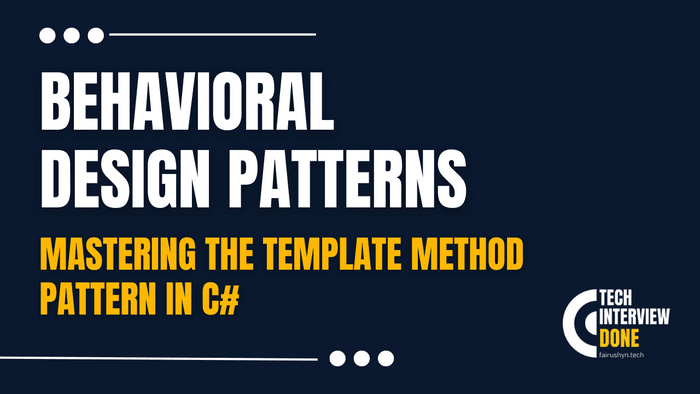Mastering the Template Method Pattern in C#
A Comprehensive Guide for Experienced Software Engineers
3 min read · — #design-patterns#structrural-patterns#template-method
Introduction
In the ever-evolving landscape of software development, design patterns serve as the cornerstone for crafting efficient, scalable, and maintainable applications. Among these patterns, the Template Method stands out as a pivotal architectural blueprint, especially in the realm of behavioral design patterns. This pattern offers a skeleton for algorithm steps, allowing subclasses to redefine certain steps without changing the algorithm's structure. This comprehensive guide is tailored for software engineers with a wealth of experience who seek to deepen their understanding of the Template Method pattern in C#. Whether you're aiming to ace your technical interviews or simply wish to elevate your design skills, this exploration into the Template Method pattern will arm you with the knowledge and practical insights needed to apply this pattern effectively in real-world scenarios.
The Essence of the Template Method Pattern
The Template Method pattern falls under the category of behavioral design patterns. It's primarily used to define the program skeleton of an algorithm in a method, deferring some steps to subclasses. This design pattern allows subclasses to override specific steps of an algorithm without altering its structure. The essence of this pattern is to capture the invariant parts of a method operation and leave the variant parts to be implemented or customized by the subclasses.
Key Components
- Abstract Class: Defines abstract methods for the steps that subclasses need to implement and a template method defining the skeleton of an algorithm.
- Concrete Class: Implements the abstract methods of the abstract class, providing specific behavior for the algorithm steps.
Real-world Scenario: Data Processing System
Imagine you're developing a data processing system that needs to read, process, and save data. However, the source and format of the data can vary (e.g., XML, JSON, CSV). Here's where the Template Method pattern shines.
Step 1: Define the Abstract Class
First, you define an abstract class that outlines the steps for processing data:
public abstract class DataProcessor
{
// Template method
public void ProcessData()
{
ReadData();
ProcessData();
SaveData();
}
protected abstract void ReadData();
protected abstract void ProcessData();
protected abstract void SaveData();
}Step 2: Implement Concrete Classes
Next, you create concrete classes for each data format, implementing the specific steps required for processing that type of data.
For JSON Data:
public class JsonDataProcessor : DataProcessor
{
protected override void ReadData()
{
Console.WriteLine("Reading JSON Data");
}
protected override void ProcessData()
{
Console.WriteLine("Processing JSON Data");
}
protected override void SaveData()
{
Console.WriteLine("Saving JSON Data");
}
}For XML Data:
public class XmlDataProcessor : DataProcessor
{
protected override void ReadData()
{
Console.WriteLine("Reading XML Data");
}
protected override void ProcessData()
{
Console.WriteLine("Processing XML Data");
}
protected override void SaveData()
{
Console.WriteLine("Saving XML Data");
}
}Step 3: Utilizing the Template Method
To use these processors, you simply instantiate the appropriate concrete class and call its ProcessData method.
class Program
{
static void Main(string[] args)
{
DataProcessor jsonDataProcessor = new JsonDataProcessor();
jsonDataProcessor.ProcessData();
DataProcessor xmlDataProcessor = new XmlDataProcessor();
xmlDataProcessor.ProcessData();
}
}This approach allows for the processing of different data formats without altering the algorithm's structure, showcasing the flexibility and power of the Template Method pattern.
Conclusion
The Template Method pattern is a powerful tool in a software engineer's arsenal, offering a robust framework for defining algorithms while allowing for flexibility and customization. By mastering this pattern, you enhance your ability to design systems that are both adaptable and cohesive. As you prepare for your technical interviews or seek to improve your design skills, consider the Template Method pattern as a testament to the elegant solutions that experienced software engineers can create to tackle complex problems. Embrace this pattern, and let it guide you in crafting software that stands the test of time.
